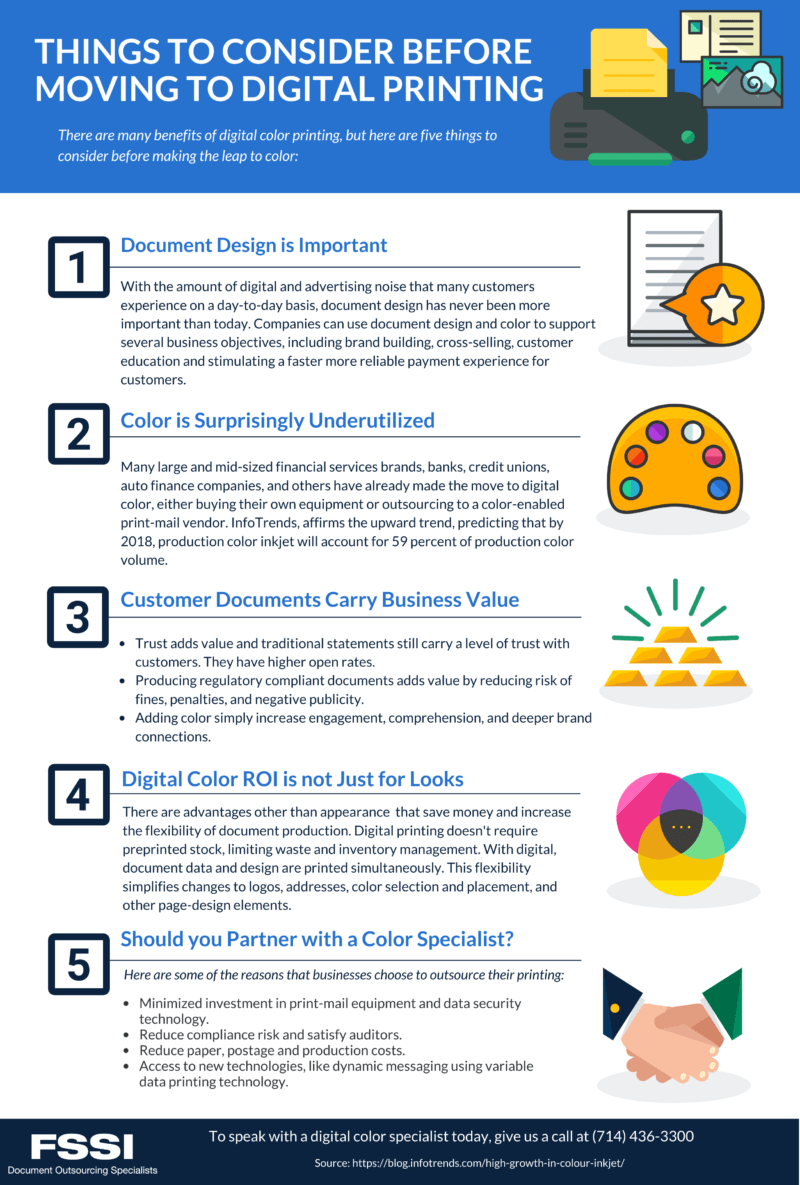5 Simple Techniques For Digital Printing
5 Simple Techniques For Digital Printing
Blog Article
The Ultimate Guide To Digital Printing
Table of ContentsThe Basic Principles Of Digital Printing 9 Simple Techniques For Digital PrintingUnknown Facts About Digital PrintingSome Ideas on Digital Printing You Should KnowFacts About Digital Printing RevealedExcitement About Digital Printing
Variable data printing, such as direct mail with personalized codes and addresses, is preferably suited for electronic printing. Digital fast printing just requires 4 steps of design, review, printing and binding to get every little thing done. Digital quick printing has an unrivaled advantage: print on demand.According to PMMI, digital printing enables brand names and manufacturers to respond swiftly to customer needs while improving the supply chain, decreasing warehousing price and waste, and taking pleasure in faster time to market. That all noises terrific, however how does this innovation do all that? The significant differentiator of these technologies is that there are no set up charges and no plates with electronic printing.
The 15-Second Trick For Digital Printing
According to Wikipedia, the best difference between electronic printing and typical techniques such as lithography, flexography, gravure, or letterpress - Digital Printing is that there is no requirement to replace printing plates in electronic printing, whereas in these analog printing approaches the plates are continuously changed. This results in quicker turnaround time and reduces price when utilizing electronic printing.
Speedy manufacturing indicates obtaining your product to market faster. It additionally suggests it's less complicated and faster to make changes in the future, when you change a recipe, add a SKU, or produce seasonal product packaging. Digital printing is highly versatile, so it's very easy to make adjustments to the plan style swiftly. It all returns to the plates.
Much more stock can mean more waste later on. With traditional printing techniques, short-run printing is simply not possible. Because a great design can make or break your item, digital printing constantly creates premium, clear and colorful graphics each time. Digital printing on flexible bags includes the bright, dynamic, and precise graphics that practically beckon consumers to connect and touch them.
Digital printing is the procedure of printing digital-based pictures straight onto a variety of media substratums. There is no need for a printing plate, unlike with balanced out printing. Digital files such as PDFs or desktop computer publishing files can be sent directly to the electronic printing machine to publish on paper, image paper, canvas, fabric, synthetics, cardstock and various other substratums.
Digital Printing Things To Know Before You Buy
According to PMMI, electronic printing allows brands and makers to respond swiftly to customer demands while improving the supply chain, lowering warehousing expense and waste, and enjoying faster time to market. That all sounds excellent, but how does this innovation do all that? The significant differentiator of these technologies is that there are no set up charges and no plates with digital printing.
According to Wikipedia, the best distinction in between electronic printing and typical methods such as lithography, flexography, gravure, or letterpress Find Out More is that there is no need to replace printing plates in electronic printing, whereas in these analog printing techniques the plates are repeatedly changed. This leads to quicker turn-around time and decreases cost when using electronic printing.

6 Simple Techniques For Digital Printing
Much more stock can indicate more waste down the roadway. With standard printing approaches, short-run printing is just not possible. Since an excellent design internet can make or break your item, digital printing constantly produces premium, clear and colorful graphics each time. Digital printing on adaptable pouches includes the intense, vivid, and precise graphics that practically bid consumers to get to out and touch them.

According to PMMI, digital printing enables brand names and suppliers to react promptly to client needs while improving the supply chain, lowering warehousing price and waste, and appreciating faster time to market. That all sounds wonderful, yet just how does this modern technology do all that? The significant differentiator of these modern technologies is that there are no set up fees and no plates with digital printing.
Not known Facts About Digital Printing
This results in quicker turn-around time and decreases cost when using electronic printing.
Rapid production means obtaining your item to market faster. It also implies it's simpler and faster to make modifications later, when you alter a recipe, include a SKU, or create seasonal product packaging. Digital printing is very flexible, so it's simple to make adjustments to the bundle design swiftly. It all goes back to the plates.

Unknown Facts About Digital Printing
Digital printing is the procedure of printing digital-based photos directly onto a range of media substrates. There is no need for a printing plate, unlike with countered printing. Digital data such as PDFs or desktop computer posting files can be sent directly to the electronic printing machine to print on paper, photo paper, canvas, fabric, synthetics, cardstock and other substratums.
Report this page